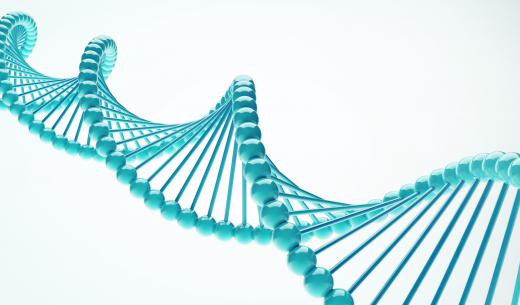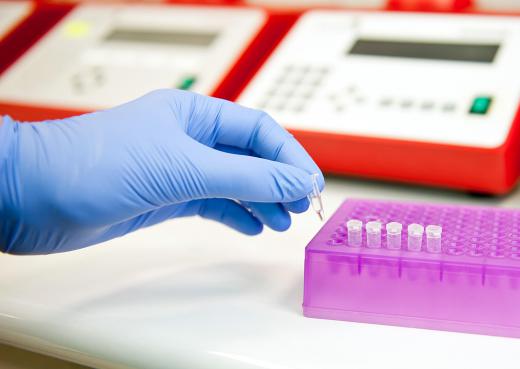What is Particle Bombardment?
 Mary McMahon
Mary McMahon
Particle bombardment is a technique which can be used to introduce foreign DNA to a cell culture. There are several methods of particle bombardment available, most involving the use of a “gene gun,” a device which is designed to deliver particles into a cell culture reliably and efficiently. This technique is used in labs all over the world for research and development purposes, with the use of specialized equipment, some of which is customized for specific applications.
In particle bombardment, particles, often of heavy metals, are used to breach the cell wall. If the particles are coated in DNA, the foreign DNA will be introduced to the cell through the breaks in the cell wall. If the cell walls are suspended in a solution of DNA, some will be picked up by the particles as they move through the solution, forcing the DNA into the cell. In either case, foreign DNA which has been customized for the organism being researched is essentially injected into the cells.

The earliest uses of particle bombardment were in the development of transgenic crops. Using this technique, researchers could do things like introducing genes for herbicide resistance to cell cultures which would later be used to develop crops. Other genetic modifications could be introduced as well. Gradually, the use of the technique expanded to cultures of bacteria and animal cells, as researchers refined particle bombardment.

This technique does require some finesse on the part of the technician performing it. The particles must be carefully chosen and delivered in a controlled fashion. The goal is to introduce the particles with minimal damage to the cells, so that they can recover after the particle bombardment and continue growing and dividing. If the cells are too damaged, they will die off. On the other hand, if the particle bombardment is not fully delivered, some of the cells in a culture will not absorb the foreign DNA.

Researchers also need to make sure that they are introducing the appropriate DNA to their target cells culture. If the DNA strands being inserted are not well matched to the organism, the particle bombardment may fail because they cannot be integrated into the organism, or because errors occur. This requires knowledge of genetics and a familiarity with the genome of the organism being studied to confirm that the DNA will end up where it is supposed to, and that it will function as intended by the researchers.
AS FEATURED ON:
AS FEATURED ON:













Discussion Comments
Hey, does anybody know how long it takes for the cell walls that were punched through to repair themselves? I mean, it must be a pretty quick repair to keep that DNA that was shot into them inside as they fix themselves.
According to the article, transformation of cells using particle bombardment can sometimes cause too much damage and kill the cells.
That being the case, I would imagine that if you did particle bombardment as an injection kind of thing in a living organism, it wouldn't hit all of the cells at once, right? If it did, the potential would be to literally kill the poor creature's cells off all at once.
Last question, but not least, what happens to the metal particles after they deliver the DNA? Do they go out of the cells through the holes before then, or do they get sealed inside when the cell walls repair themselves?
If that latter is the case, I guess particle bombardment involves not just genetic modification, but also converting a tiny bit of that organism to being metal. Food for thought!
@gimbell - Whoa, you mean getting vaccinated is technically a form of genetic modification? Freaky.
That means while we're all busy worrying whether we eat genetically modified vegetables, or catch genetically modified fish, or plant genetically modified fields, most of us are already genetically modified from the immunization shots we got as babies and as kids!
Thanks for replying and taking the time to explain all of that. I had no idea that there were different kinds of vaccinations, and I definitely had no clue about exactly how they worked.
@malmal - Yes, particle bombardment has been used as a gene delivery method to provide people with DNA vaccinations, such as immunization to the flu virus.
DNA vaccinations are unique from other kinds of immunization because they don't involve injecting actual virus cells. See, vaccines comes in three "generations".
First-generation involves injecting whole cells of the virus you want a resistance to into the bloodstream so that the body's immune system reacts to them. First-generation vaccines are dangerous because sometimes the virus doesn't die, and you get sick.
Second-generation vaccines involve injecting proteins that can get the same immune reactions out of you as the disease, so that your body builds up a resistance that way. Sometimes immunizations done this way don't actually make you immune to that disease, though – second-generation vaccines can fail.
Finally, DNA vaccines are the third-generation ones. The DNA that is injected using particle bombardment is synthesized -- made in a lab, not taken from real cells like the other two -- and genetically modified to create certain antigens in your body.
In the end, your cells actually convert the antigens into proteins that your body will make an immune reaction toward. It's a safe and effective way to be immunized for many diseases.
So this is how scientists have been able to learn genetic engineering of plants. I've been wondering how exactly you would combine the genetic make up of several plant species together without actually making cultivars or doing direct splicing.
The name "gene gun" sounds like something out of a science fiction story -- especially since I looked it up a bit and found out that the DNA used to coat the metal particles is refereed to as plasmids.
Plasmids, if you didn't know, are an injection (albeit with an old-fashioned needle and syringe) that you use to give yourself super powers in the BioShock video game series. The game's science is more fascinating to me now, knowing the concept of plasmids that alter DNA is actually based in reality. Particle bombardment is what they are getting at there.
I wonder if some day soon we will have plasmid-shooting gene guns and use them in a way similar to BioShock's plotline? In the games, plastic surgery and genetic manipulation have run rampant as mankind became obsessed with physical perfection, and they took things too far until people weren't quite human anymore.
Hopefully somebody pays attention to cautionary tales like this if and when we invent real life human-use plasmids...
Is particle bombardment the method by which immunization injections and inoculations deliver the substance to a person's cells, by any chance?
Post your comments